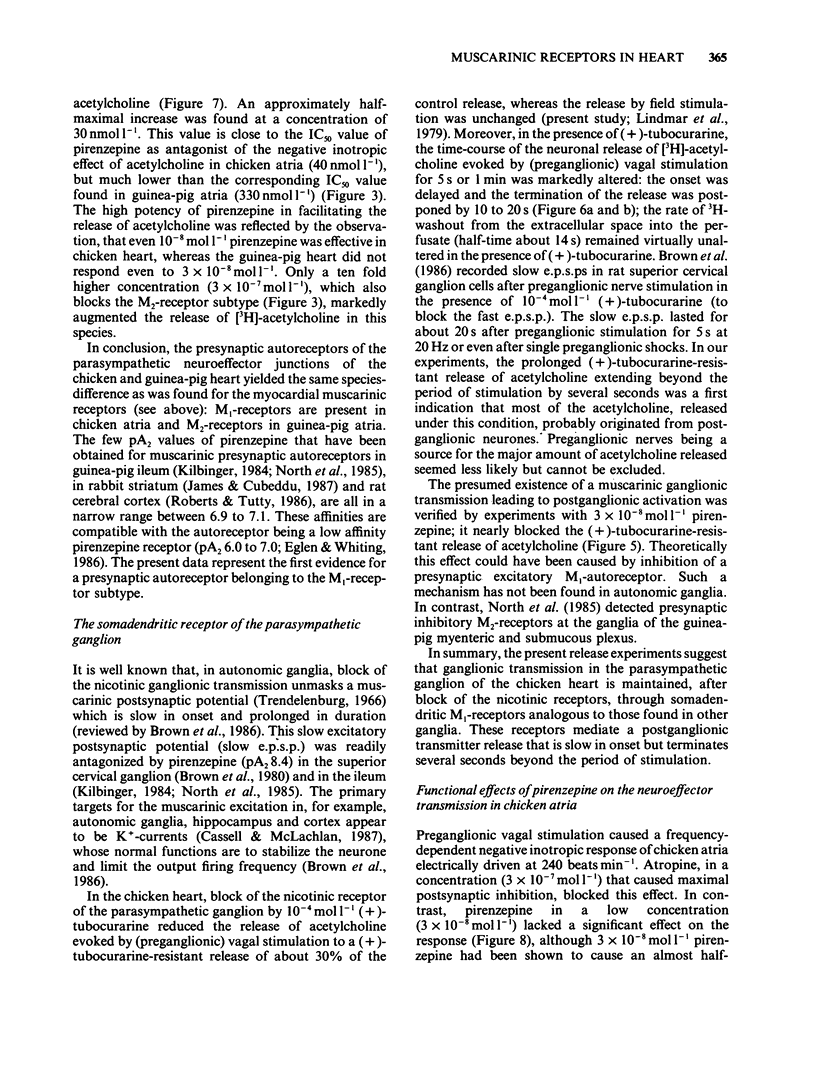Abstract
1. Electrically driven chicken and guinea-pig atria were used to investigate the negative inotropic effects of the muscarinic agonists methacholine and acetylcholine (ACh). The release of ACh from isolated hearts into the perfusate in response to (preganglionic) vagal or (pre- and postganglionic) field stimulation was bioassayed on the guinea-pig ileum or determined by labelling with [3H]-choline. 2. Concentration-response curves for the negative inotropic effect of methacholine were shifted to the right by pirenzepine in various concentrations (0.03 to 10 mumol l-1). The pA2 values were 7.76 in chicken atria and 6.53 in guinea-pig atria. Pirenzepine and atropine antagonized the negative inotropic response to 0.3 mumol l-1 ACh. The half-maximally effective concentrations (IC50) of pirenzepine (Pz) and atropine were 40 and 5.4 nmol l-1 in chicken atria and 330 and 3.5 nmol l-1, respectively, in guinea-pig atria. Thus, the respective potency ratios (IC50Pz/IC50atropine) were 7.4 and 94.3 in the two species. 3. Pirenzepine in low concentrations increased the release of unlabelled and 3H-labelled ACh from isolated hearts evoked by vagal and field stimulation only in chicken, but not in guinea-pigs. The half-maximally-effective concentration of pirenzepine was about 30 nmol l-1 in the chicken heart, whereas, in the guinea-pig heart, an increased release was observed at 300 nmol l-1. 4. (+)-Tubocurarine [(+)-Tc; 100 mumol l-1] reduced the release of ACh evoked by (preganglionic) vagal stimulation to a (+)-Tc-resistant release of about 30%. The time-course of the neuronal release of [3H]-ACh was markedly altered: the onset was delayed and the termination was extended beyond the period of stimulation (1 min or 5s) by several seconds. The (+)-Tc-resistant release was nearly abolished by 30 nmol l-1 pirenzepine. 5. In conclusion, the pre- and post-synaptic muscarinic receptors of the parasympathetic neuroeffector junction of the heart both belong to the M1-subtype in the chicken and to an M2-subtype in the guinea-pig. Block of the nicotinic ganglionic transmission in the chicken heart by (+)-Tc unmasked a muscarinic transmission, which presumably was mediated through M1-receptors stimulating a low and prolonged postganglionic release of ACh.
Full text
PDF









Selected References
These references are in PubMed. This may not be the complete list of references from this article.
- ARUNLAKSHANA O., SCHILD H. O. Some quantitative uses of drug antagonists. Br J Pharmacol Chemother. 1959 Mar;14(1):48–58. doi: 10.1111/j.1476-5381.1959.tb00928.x. [DOI] [PMC free article] [PubMed] [Google Scholar]
- Brown D. A., Forward A., Marsh S. Antagonist discrimination between ganglionic and ileal muscarinic receptors. Br J Pharmacol. 1980;71(2):362–364. doi: 10.1111/j.1476-5381.1980.tb10948.x. [DOI] [PMC free article] [PubMed] [Google Scholar]
- Brown J. H., Goldstein D., Masters S. B. The putative M1 muscarinic receptor does not regulate phosphoinositide hydrolysis. Studies with pirenzepine and McN-A343 in chick heart and astrocytoma cells. Mol Pharmacol. 1985 May;27(5):525–531. [PubMed] [Google Scholar]
- Cassell J. F., McLachlan E. M. Muscarinic agonists block five different potassium conductances in guinea-pig sympathetic neurones. Br J Pharmacol. 1987 Jun;91(2):259–261. doi: 10.1111/j.1476-5381.1987.tb10279.x. [DOI] [PMC free article] [PubMed] [Google Scholar]
- Dieterich H. A., Lindmar R., Löffelholz K. The role of choline in the release of acetylcholine in isolated hearts. Naunyn Schmiedebergs Arch Pharmacol. 1978 Jan-Feb;301(3):207–215. doi: 10.1007/BF00507039. [DOI] [PubMed] [Google Scholar]
- Dieterich H. A., Löffelholz K. Effect of coronary perfusion rate on the hydrolysis of exogenous and endogenous acetylcholine in the isolated heart. Naunyn Schmiedebergs Arch Pharmacol. 1977 Jan;296(2):143–148. doi: 10.1007/BF00508466. [DOI] [PubMed] [Google Scholar]
- Eglen R. M., Whiting R. L. Muscarinic receptor subtypes: a critique of the current classification and a proposal for a working nomenclature. J Auton Pharmacol. 1986 Dec;6(4):323–346. doi: 10.1111/j.1474-8673.1986.tb00661.x. [DOI] [PubMed] [Google Scholar]
- Hammer R., Giachetti A. Muscarinic receptor subtypes: M1 and M2 biochemical and functional characterization. Life Sci. 1982 Dec 27;31(26):2991–2998. doi: 10.1016/0024-3205(82)90066-2. [DOI] [PubMed] [Google Scholar]
- James M. K., Cubeddu L. X. Pharmacologic characterization and functional role of muscarinic autoreceptors in the rabbit striatum. J Pharmacol Exp Ther. 1987 Jan;240(1):203–215. [PubMed] [Google Scholar]
- Lindmar R., Löffelholz K. Muscarinic M1-receptors mediate the negative inotropic effect of methacholine in chicken but not in guinea-pig atria. Eur J Pharmacol. 1987 Jul 23;139(3):359–360. doi: 10.1016/0014-2999(87)90596-6. [DOI] [PubMed] [Google Scholar]
- Lindmar R., Löffelholz K., Weide W. Inhibition by pentobarbital of the acetylcholine release from the postganglionic parasympathetic neuron of the heart. J Pharmacol Exp Ther. 1979 Aug;210(2):166–173. [PubMed] [Google Scholar]
- Lindmar R., Löffelholz K., Weide W. Interstitial washout and hydrolysis of acetylcholine in the perfused heart. Naunyn Schmiedebergs Arch Pharmacol. 1982 Mar;318(4):295–300. doi: 10.1007/BF00501168. [DOI] [PubMed] [Google Scholar]
- Lindmar R., Löffelholz K., Weide W., Witzke J. Neuronal uptake of choline following release of acetylcholine in the perfused heart. J Pharmacol Exp Ther. 1980 Dec;215(3):710–715. [PubMed] [Google Scholar]
- Löffelholz K., Brehm R., Lindmar R. Hydrolysis, synthesis, and release of acetylcholine in the isolated heart. Fed Proc. 1984 Aug;43(11):2603–2606. [PubMed] [Google Scholar]
- Löffelholz K., Pappano A. J. The parasympathetic neuroeffector junction of the heart. Pharmacol Rev. 1985 Mar;37(1):1–24. [PubMed] [Google Scholar]
- North R. A., Slack B. E., Surprenant A. Muscarinic M1 and M2 receptors mediate depolarization and presynaptic inhibition in guinea-pig enteric nervous system. J Physiol. 1985 Nov;368:435–452. doi: 10.1113/jphysiol.1985.sp015867. [DOI] [PMC free article] [PubMed] [Google Scholar]
- O'Rourke S. T., Vanhoutte P. M. Subtypes of muscarinic receptors on adrenergic nerves and vascular smooth muscle of the canine saphenous vein. J Pharmacol Exp Ther. 1987 Apr;241(1):64–67. [PubMed] [Google Scholar]
- Trendelenburg U. Transmission of preganglionic impulses through the muscarinic receptors of the superior cervical ganglion of the cat. J Pharmacol Exp Ther. 1966 Dec;154(3):426–440. [PubMed] [Google Scholar]


